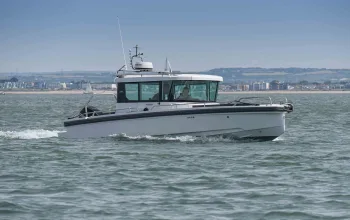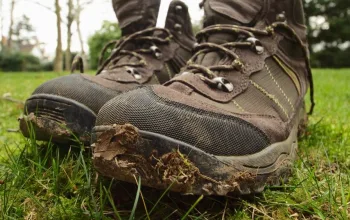Surfing is all about that moment of triumph when you are standing up on your board, feeling the power of the wave as you glide down its surface. It takes perseverance and patience to get there, but anyone can do it – all you need to get started is to be reasonably fit and be able to swim 50 metres.
Beginners are taught to stand on a board by practising on ‘white water’, which is the wave after it has broken at the peak, and then graduate onto surfing ‘green waves’ – waves before they have broken. Learning to paddle out to where you can catch a green wave is another challenge. Wearing the right wetsuit can make the difference between having a good time and hypothermia. Advances in wetsuit technology mean that they are warmer and more flexible than they once were. Wetsuits are made of neoprene and work by trapping water between your skin and the suit, which is then warmed by your body heat. Glued seams offer better insulation than stitched seams, which can let water in. Wetsuits often have different panels of thickness, to keep your core more insulated than your arms and legs.
In UK waters in the winter and spring, you will need a 5mm- or 4mm-thick wetsuit (at the thickest part), while between June and October a full-length 3mm suit should suffice. September and October are the months with the warmest water – temperatures can be as high as 18ºC. The autumn is a great time to surf – the days are long, and the waves less crowded than in summer. How to get started The best way to get surfing is to take lessons. There are many different surfing schools in the UK and around the world, offering a pick ‘n’ mix of courses to get you going.
"Surfing is all about that moment of triumph"
Beginner courses can last from a half-day taster session to a week-long training holiday. In group lessons with an instructor, the pupil/teacher ratio is usually 8:1. In Britain, you can expect to pay around £30 for a half- day’s lessons, with about two hours on the water plus some time learning theory and safety on the shore, or about £50 for a whole day – although you may prefer to spread two half-day lessons over a weekend. The hire of large, soft-foam-covered boards and wetsuits is included in the price of lessons.
In the UK, surf schools are regulated by the British Surfing Association (BSA), which has a system of approving schools that meet its criteria for a high quality of teaching and safety. All BSA-accredited schools can teach beginners how to surf. There are four levels of school, depending on how qualified the instructors are: a Level One school can teach beginners and improvers, through to a Level Four school that can train elite riders. The BSA also awards instructors BSA qualifications for teaching, from Levels One to Three – three being the most advanced. There are about 50 BSA-approved schools to choose from (see britsurf.co.uk). It is best to try surfing with a BSA-approved school in the UK to see if you like it, before spending a lot of money on a surfing holiday abroad. Another advantage of learning in the UK is that you don’t have to travel far to find a surf beach near you. However, if you fancy learning in a warm location, there are many companies offering surfing holidays and surfing camps in Europe and further afield. Prices vary widely for a week’s surfing. Some of the most popular destinations for surfing holidays within easy reach of the UK are Portugal, France, Morocco, and the Canary Islands. Outside the UK, some countries have their own surfing associations to help you choose the best school.
How to Improve
It can take several lessons before you reach a level where you feel comfortable to start going it alone. Dr Sanjit Singh, 31, from Cardiff, has been on occasional surfing trips for the past two years with his brother and some friends, and says: ‘It is always a challenge exhilarating and satisfying because you are harnessing the power of the waves. I stood up in my second lesson, but can now stand up almost every time. This summer I am going to learn how to turn.’ It takes most people a week’s worth of lessons, on average, to get to the point where they are ready to practise their skills alone.
Continued...
 Barry Hall, the BSA National Coaching Director, says: ‘You need to surf at lifeguarded beaches, between the black-and-white chequered flags. Start off in small waves, about three feet high, and be aware of the surfing conditions, such as currents.’ You can find out where and when beaches are lifeguarded from your local council or from the RNLI, who provide the lifeguard patrols on some beaches. ‘Always make sure children are supervised by an adult, and watch the weather and conditions, as children are more prone to hypothermia, sunstroke and sunburn,’ says Barry. It is a good idea to continue to use the same type of softboards that you have been using in beginners’ lessons to help you progress quickly and keep your confidence up. You can buy these for about £280, but as you are likely to outgrow a softboard fast, it is better to rent one from your local surf school. However, if you have a family it may be worth investing in a softboard to share and pass around, especially for children.
Barry Hall, the BSA National Coaching Director, says: ‘You need to surf at lifeguarded beaches, between the black-and-white chequered flags. Start off in small waves, about three feet high, and be aware of the surfing conditions, such as currents.’ You can find out where and when beaches are lifeguarded from your local council or from the RNLI, who provide the lifeguard patrols on some beaches. ‘Always make sure children are supervised by an adult, and watch the weather and conditions, as children are more prone to hypothermia, sunstroke and sunburn,’ says Barry. It is a good idea to continue to use the same type of softboards that you have been using in beginners’ lessons to help you progress quickly and keep your confidence up. You can buy these for about £280, but as you are likely to outgrow a softboard fast, it is better to rent one from your local surf school. However, if you have a family it may be worth investing in a softboard to share and pass around, especially for children.
The cost of renting a board can vary depending on the time of year and from place to place but it can be cheaper if you rent for long periods of time, or have your own wetsuit. Wetsuits cost between £50 and £200. (Continued) Buying a board ‘Most people surf regularly, about four hours a week, for four to six months before they start looking to buy a board,’ says Scott Gardner, who runs Wight Water watersports centre. About 100 hours in the water will see you through to an intermediate standard. This means that you are confident in your abilities to get up on white water almost 100 per cent of the time, have a decent level of control, can turn both ways on green waves, and paddle effectively.
A Mini Mal, short for ‘Mini Malibu’, is the kind of board most people buy as a first hard board, and it is normally about seven feet long. The BSA says that 70 per cent of surfers have used or do use a Mini Mal because it is manoeuvreable, buoyant, and fast. Expect to pay around £220 for a Mini Mal. Some people then decide to progress their surfing further and mostly choose either a zippy shortboard (less then 7ft long) or a classic longboard (9ft and over), or one of the many variations on these. Before you choose, have coaching sessions to try out different boards. You might develop a ‘cruisy’ style suitable for longboarding, or want more manoeuvreability for fast turns, in which case you would go for a shortboard. Shortboards can cost from £180 upwards, whereas custom-made longboards can cost more than £500.
When you have found your ideal board, and taken the months or years needed to get proficient at riding it, you can push your skills to the next level by travelling abroad. If you want to get into competing, join a local club– you can find a list of clubs on the BSA website. As well as friendly club contests, there is an annual inter-club competition – the British Interclubs. If you do well, clubs affiliated with the BSA can provide elite coaching. Membership of a club can start at as little as £10 a year, up to £25 a year for the Croyde Surf Club in Devon which is one of the top surf clubs in the UK.
One last thing before you step into the water unsupervised: make sure you get to grips with the rules of the waves in order to be a safe and considerate surfer
Surf Etiquette…
- The Number One rule is that the surfer nearest to the peak of the wave has priority. Get out of their way if you are on collision course Snaking a surfer catching a wave means barging into prime position in front of them, cutting them up, and it won’t win you any friends.
- Paddle out wide from the peak of the wave to avoid crashes with other surfers riding the same wave.
- Don’t attempt to catch a wave if you fear you could collide with another surfer paddling in front of you.
- Wear a leash attaching your board to your leg. Keep your board with you so that it does not injure others.
- If you get caught on the inside of a breaking wave, with surfers bearing down on you, paddle for the white water.
- Surf in conditions appropriate for your ability or you could be putting yourself and others in danger.
Surf Speak...
- stick - surfboard
- fins - curved underwater stabilisers for a board
- leash -a rubber cord attached to the board and attached to your ankle with a Velcro strap
- surf wax - synthetic or natural wax that is rubbed onto the top of a hard surfboard to aid grip
- take off - catch a breaking wave and start to ride
- spinout - when the surfboard fins break away from the water, giving a sensation of losing control
- sweet spot - the ideal place for the surfer to place their feet for maximum balance and board control
- trim - to move position on the board for maximum speed
- hang ten - the act of hanging all ten toes over the front edge of the longboard
- walking the nose - a longboard manoeuvre where the surfer walks towards the nose of the board turn
- turtle - when longboarders flip their board over into an oncoming wave to get through it
- duck dive - plunging your shortboard under water into an oncoming wave
- overhead - a wave that is over six feet tall
- gangbuster - surf of good quality and height





















